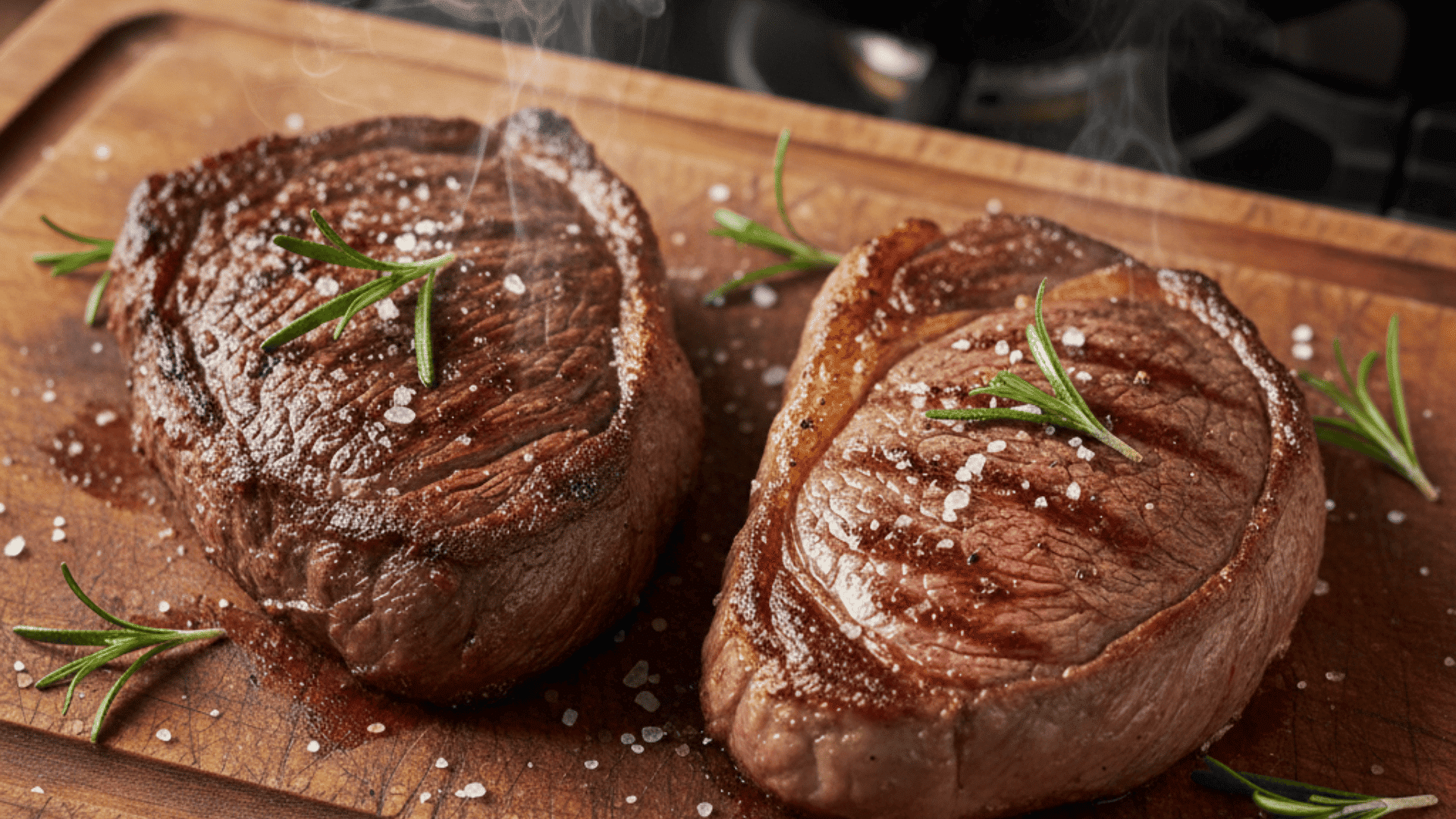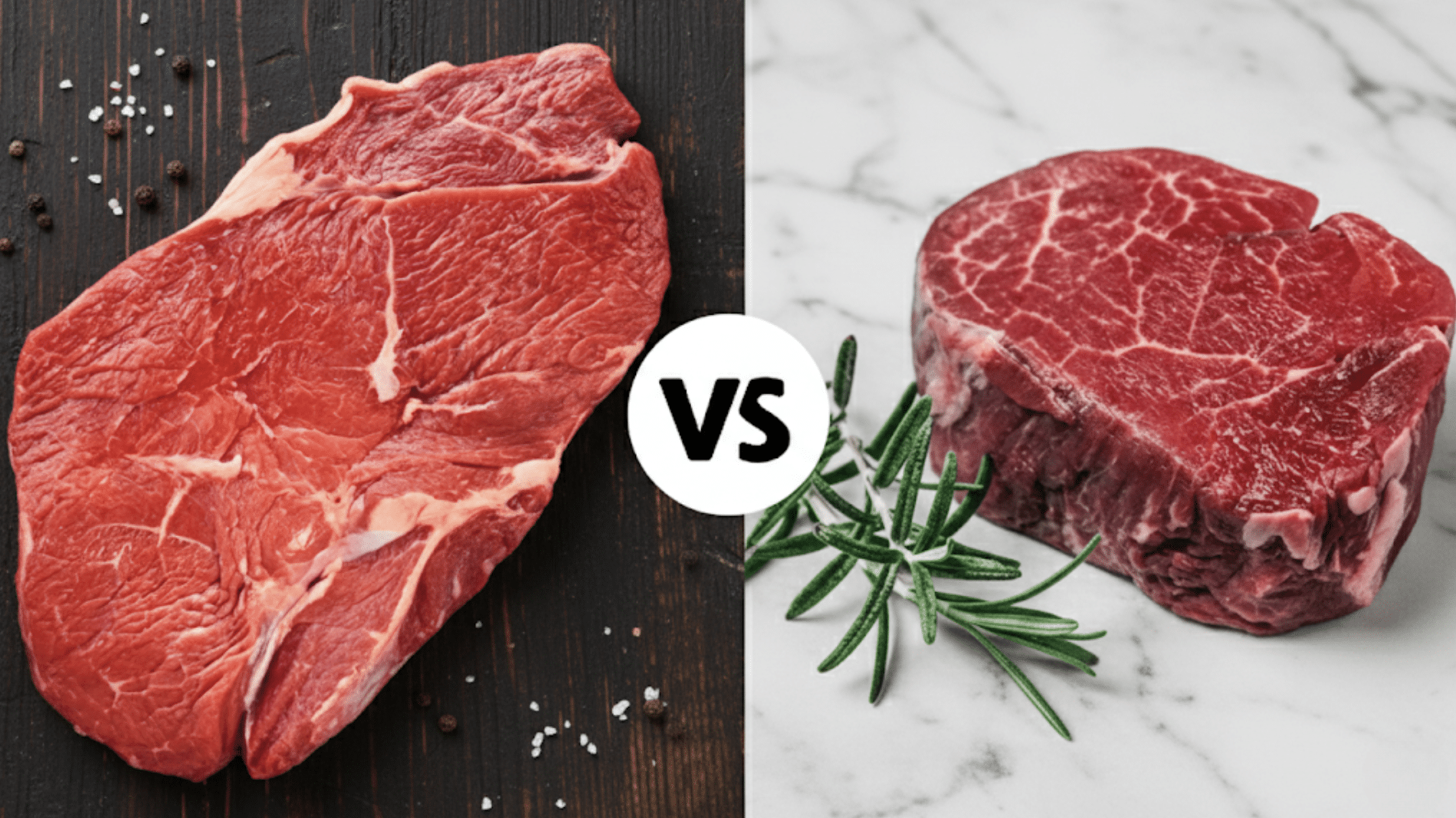Standing at the meat counter, it’s easy to feel torn. Do you go with familiar beef or try lean bison? I’ve had the same question, so I’ll break down bison vs beef nutrition in plain terms.
Here, you’ll see clear numbers on calories, fat, saturated fat, cholesterol, and protein. I’ll also highlight iron, zinc, and B vitamins, since those affect energy and recovery.
You’ll learn how taste and texture differ, how farming methods can change the fat profile, and simple cooking tips at home to keep meat really tender.
By the end, you’ll know when bison makes sense, when lean beef is fine, and how to choose cuts that match your goals and your budget.
Note: I’ll share both per 100 g cooked and per 4 oz (113 g) lean comparisons since labels often switch between the two.
Nutritional Breakdown of Bison
Bison is often chosen as a leaner alternative to beef, and its nutrition reflects that balance of high protein and low fat.
- Calories & Protein: About 142 calories and 28 g of protein per 100 g cooked; lean and protein-rich.
- Fat Content: Only 2–3 g of fat with less than 1 g saturated fat; much lower than beef.
- Vitamins: High in B12 and niacin, which support energy metabolism and nerve health.
- Minerals: Strong source of iron and selenium; zinc is also present in useful amounts.
- Farming Practices: Often pasture-raised with fewer added inputs, leading to better omega-3 balance.
In summary, Bison is nutrient-dense without the extra fat, making it a strong option for people looking to cut calories while still getting essential vitamins and minerals.
Nutritional Breakdown of Beef
Beef remains one of the most popular proteins worldwide, valued for its flavor, variety, and nutrient density.
- Calories & Protein: Around 235 calories and 27 g of protein per 100 g cooked; dense and filling.
- Fat Content: Fat varies by cut; 13+ g in higher-fat options, lower in lean cuts like sirloin or tenderloin.
- Vitamins: Excellent source of B12, crucial for red blood cells and nervous system function.
- Minerals: High in iron for oxygen transport and often richer in zinc than bison.
- Availability: Widely accessible in many cuts and price ranges, making it versatile for all types of meals.
In summary, Beef provides complete protein, strong mineral content, and unmatched variety. Choosing lean cuts allows you to enjoy its benefits without taking in too much fat.
Bison vs. Beef: Key Nutritional Differences
| Nutrient | Bison (100g) | Beef (100g) | Key Points |
|---|---|---|---|
| Calories | ~142 kcal | ~235 kcal | Bison is leaner, fewer calories. |
| Total Fat | ~2–3 g | ~13 g | Beef has more fat overall. |
| Saturated Fat | ~0.9 g | ~5–6 g | Bison is much lower. |
| Cholesterol | ~82 mg | ~87 mg | Similarly, bison is slightly lower. |
| Protein | ~28 g | ~27 g | Both are excellent protein sources. |
| Iron | Slightly higher | Strong | Bison edges ahead. |
| Zinc | Good | Often higher | Beef has an advantage here. |
| Omega-3 Balance | Better (grass-fed) | Lower | Bison are usually more favorable. |
Bison is the leaner, lower-fat option, while beef offers more zinc and wider availability. Both deliver protein and essential nutrients; your choice depends on goals and budget.
Health Considerations: Comparing Bison and Beef
When comparing bison and beef, a few health factors stand out.
- Heart Health: Bison is naturally leaner with less saturated fat, making it easier on cholesterol levels. Lean beef can be a good option too, but you’ll need to choose cuts like sirloin, tenderloin, or 90–95% lean ground.
- Weight Management: With fewer calories per serving, bison helps with calorie control while still delivering plenty of protein. This makes it useful for those trying to manage weight without losing muscle.
- Iron & Energy: Both meats are rich in heme iron, which supports oxygen transport and helps prevent anemia. Bison often has a slight edge in iron, while beef usually offers more zinc for immune health.
- Digestibility: Some people find bison easier to digest because of its lower fat content, while beef can feel heavier depending on the cut.
- Sustainability: Bison are often pasture-raised and grass-fed, with fewer added hormones or antibiotics. Beef is more commonly grain-finished, though grass-fed beef is available at a higher cost.
Bison is often better for heart health, calorie control, and sustainability, while beef provides affordability, versatility, and slightly more zinc. Both remain nutrient-rich red meats when eaten in moderation.
Bison vs. Beef: Taste, Texture, and Cooking Differences

Understanding how bison and beef differ in taste, texture, and cooking requirements will help you make the most of each meat and avoid common cooking mistakes that can ruin your meal.
1. Taste Profile Differences
Bison offers a slightly sweeter, cleaner flavor that many describe as more natural and less gamey than expected. The meat has a subtle richness without being overwhelming.
Beef, on the other hand, delivers a richer, more familiar taste with deeper fat-driven flavors that most people grew up enjoying. The difference is noticeable but not dramatic for first-time bison eaters.
- Bison has a milder, sweeter taste than expected
- Beef offers richer, more familiar flavors
- Both work well in traditional recipes
2. Texture and Cooking Challenges
Bison’s leaner composition means it has a firmer texture and can become tough if overcooked, while beef’s higher fat content provides more moisture and forgiveness during cooking.
This fundamental difference requires adjusting your cooking approach, especially for steaks and burgers, where texture matters most. The lack of marbling in bison makes timing crucial for tender results.
- Bison cooks faster due to lower fat content
- Beef remains tender longer during cooking
- Both benefit from proper resting after cooking
3. Essential Cooking Tips
Success with bison means adopting medium-rare to medium doneness, while beef can handle a wider range of cooking temperatures. Bison steaks shine when cooked quickly over high heat, then rested properly.
For ground meat applications like burgers or chili, both meats perform similarly, though bison may need added moisture from vegetables or sauces to prevent drying out.
- Cook bison steaks to 130-135°F for optimal tenderness
- Add moisture when using ground bison in recipes
- Both meats work excellently in slow-cooked dishes
Whether you choose bison for its health benefits or beef for its familiarity, understanding these cooking differences ensures delicious results every time.
Which One Should You Choose?
The choice between bison and beef ultimately comes down to your personal health goals, budget, and taste preferences. Here’s a straightforward breakdown to help you decide which fits better into your lifestyle.
- Choose bison if you prioritize lean protein, need lower saturated fat options, or want naturally raised meat without antibiotics and hormones.
- Choose beef if you’re working with a tighter budget, need easy grocery store availability, or prefer the familiar taste and cooking versatility.
- For heart health focus, bison offers significantly less saturated fat and cholesterol, making it the better choice for cardiovascular concerns.
- For cooking flexibility, beef provides more cut options and forgiveness in the kitchen, while bison requires more careful temperature control.
- For budget-conscious eating, quality beef cuts often cost 30-50% less than bison, making it more accessible for regular consumption.
You don’t have to pick just one, either; many people enjoy bison for special occasions while relying on beef for everyday meals.
Final Take
Sorting out the differences in bison vs beef nutrition doesn’t have to feel complicated. You’ve now got clear numbers on calories, fat, protein, and key vitamins, along with tips for taste, texture, and cooking.
I like to think of it as matching your meat choice to your goals. If you want leaner meals with less saturated fat, bison is the better fit. If cost or easy access matters more, lean beef cuts still give you solid nutrition.
No matter which you choose, balance your plate with vegetables, grains, and beans for a meal that feels satisfying. For more practical food breakdowns and ideas, take a look at my other posts here.





